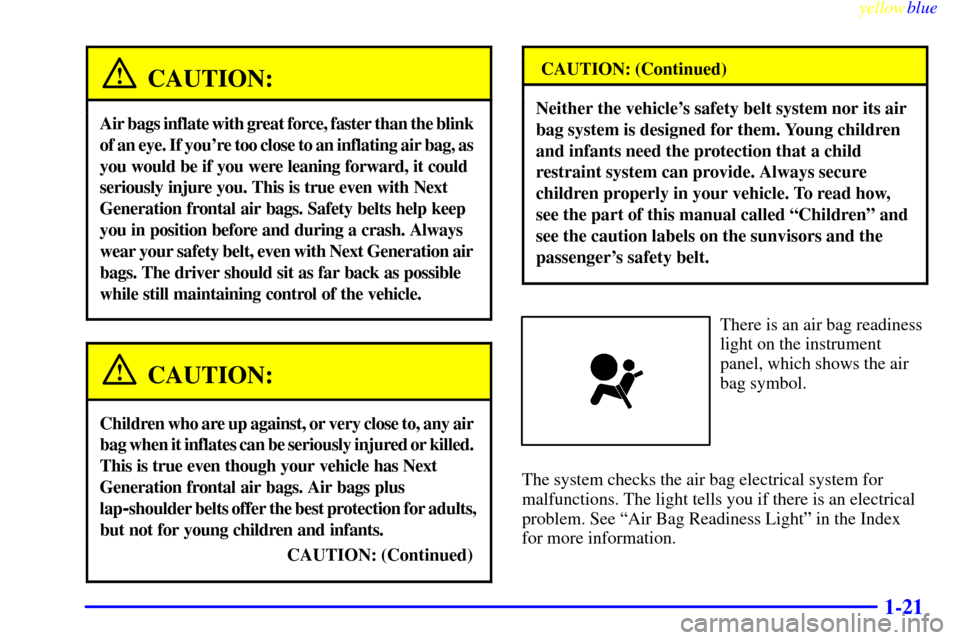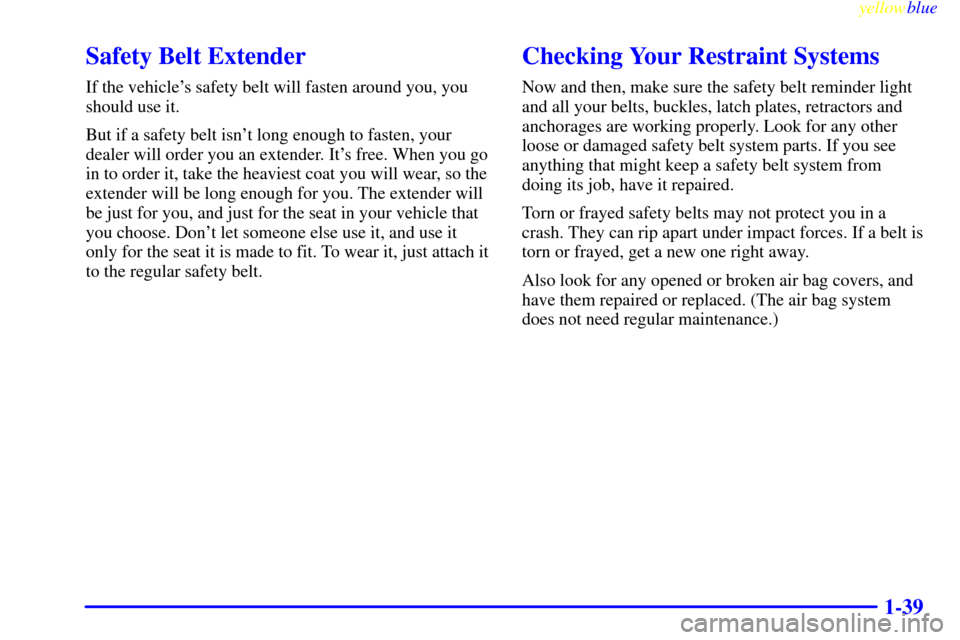Page 3 of 376
yellowblue
iii
Corvette: The American
Dream Machine
In the early '50s, it was only a designer's dream. Today
the Corvette stands alone as America's dream car
-- a
testament to its unmistakable charisma and the
excitement it inspires. Unique styling, powerful
performance and an undeniable panache have made
Corvette one of the most celebrated sports cars in
the world.
In 1953, Corvette produced 300 new lightweight
fiberglass roadsters. A handful went to project
engineers, General Motors managers, and a select group
of movie stars and celebrities. With a two
-speed
Powerglide automatic transmission, Blue Flame
six
-cylinder engine, and gleaming Polo White exterior,
the Corvette began its drive into the heart of America.
Designers freshened up the 'Vette in 1956 by adding a
removable hardtop and the famous Corvette ªcoves.º
The sculptured body enhanced its sporty look, and a
standard 210
-horsepower Chevy V8 engine solidified
Corvette's reputation as a production race car.
Page 10 of 376
yellowblue
x
For example,
these symbols
are used on an
original battery:
CAUTION
POSSIBLE
INJURY
PROTECT
EYES BY
SHIELDING
CAUSTIC
BATTERY
ACID COULD
CAUSE
BURNS
AVOID
SPARKS OR
FLAMES
SPARK OR
FLAME
COULD
EXPLODE
BATTERY
These symbols
are important
for you and
your passengers
whenever your
vehicle is
driven:
DOOR LOCK
UNLOCK
FASTEN
SEAT
BELTS
POWER
WINDOW
AIR BAG
These symbols
have to do with
your lamps:
MASTER
LIGHTING
SWITCH
TURN
SIGNALS
PARKING
LAMPS
HAZARD
WARNING
FLASHER
DAYTIME
RUNNING
LAMPS
FOG LAMPS
These symbols
are on some of
your controls:
WINDSHIELD
WIPER
WINDSHIELD
WASHER
WINDSHIELD
DEFROSTER
REAR
WINDOW
DEFOGGER
VENTILATING
FAN
These symbols
are used on
warning and
indicator lights:
ENGINE
COOLANT
TEMP
BATTERY
CHARGING
SYSTEM
BRAKE
COOLANT
ENGINE OIL
PRESSURE
ANTI-LOCK
BRAKES
Here are some
other symbols
you may see:
FUSE
LIGHTER
HORN
SPEAKER
FUEL
Vehicle Symbols
These are some of the symbols you may find on your vehicle.
Page 16 of 376
yellowblue
1-4 Sport Seat (Option)
In addition to the power seat control, there are three
other switches that help you change the shape of the
seat. There are two lumbar supports for the middle (A)
and lower (B) back. There's also a side bolster switch
(C) that adjusts the sides of the seat around you to give
you more lateral support.
For lumbar support, move each switch (A and B)
forward to inflate or rearward to deflate.
Move the side bolster switch (C) up for more side
support and down for less support.
Reclining Seatbacks
The lever for the reclining seatback is located on the
side of each seat, near the base.
To adjust the seatback, lean slightly forward to lift your
weight off the seatback. Pull completely up on the lever
until it stops, and lean back to position the seatback to
where you want it. Release the lever to lock the seatback
into place.
Page 20 of 376
yellowblue
1-8
Your vehicle has a light that
comes on as a reminder to
buckle up. (See ªSafety
Belt Reminder Lightº in
the Index.)
In most states and Canadian provinces, the law says to
wear safety belts. Here's why: They work.
You never know if you'll be in a crash. If you do have a
crash, you don't know if it will be a bad one.
A few crashes are mild, and some crashes can be so
serious that even buckled up a person wouldn't survive.
But most crashes are in between. In many of them,
people who buckle up can survive and sometimes
walk away. Without belts they could have been badly
hurt or killed.
After more than 30 years of safety belts in vehicles,
the facts are clear. In most crashes buckling up does
matter ... a lot!Why Safety Belts Work
When you ride in or on anything, you go as fast as
it goes.
Take the simplest vehicle. Suppose it's just a seat
on wheels.
Page 25 of 376
yellowblue
1-13
3. Pick up the latch plate and pull the belt across you.
Don't let it get twisted.
The lap
-shoulder belt may lock if you pull the belt
across you very quickly. If this happens, let the belt
go back slightly to unlock it. Then pull the belt
across you more slowly.When the lap portion of the belt is pulled out all the
way, it will lock. If it does, let it go back all the way
and start again. See ªLap Belt Cinch Featureº in
the Index.
4. Push the latch plate into the buckle until it clicks.
Pull up on the latch plate to make sure it is secure.
If the belt isn't long enough, see ªSafety Belt
Extenderº at the end of this section.
Make sure the release button on the buckle is
positioned so you would be able to unbuckle the
safety belt quickly if you ever had to.
Page 33 of 376

yellowblue
1-21
CAUTION:
Air bags inflate with great force, faster than the blink
of an eye. If you're too close to an inflating air bag, as
you would be if you were leaning forward, it could
seriously injure you. This is true even with Next
Generation frontal air bags. Safety belts help keep
you in position before and during a crash. Always
wear your safety belt, even with Next Generation air
bags. The driver should sit as far back as possible
while still maintaining control of the vehicle.
CAUTION:
Children who are up against, or very close to, any air
bag when it inflates can be seriously injured or killed.
This is true even though your vehicle has Next
Generation frontal air bags. Air bags plus
lap
-shoulder belts offer the best protection for adults,
but not for young children and infants.
CAUTION: (Continued)
CAUTION: (Continued)
Neither the vehicle's safety belt system nor its air
bag system is designed for them. Young children
and infants need the protection that a child
restraint system can provide. Always secure
children properly in your vehicle. To read how,
see the part of this manual called ªChildrenº and
see the caution labels on the sunvisors and the
passenger's safety belt.
There is an air bag readiness
light on the instrument
panel, which shows the air
bag symbol.
The system checks the air bag electrical system for
malfunctions. The light tells you if there is an electrical
problem. See ªAir Bag Readiness Lightº in the Index
for more information.
Page 51 of 376

yellowblue
1-39
Safety Belt Extender
If the vehicle's safety belt will fasten around you, you
should use it.
But if a safety belt isn't long enough to fasten, your
dealer will order you an extender. It's free. When you go
in to order it, take the heaviest coat you will wear, so the
extender will be long enough for you. The extender will
be just for you, and just for the seat in your vehicle that
you choose. Don't let someone else use it, and use it
only for the seat it is made to fit. To wear it, just attach it
to the regular safety belt.
Checking Your Restraint Systems
Now and then, make sure the safety belt reminder light
and all your belts, buckles, latch plates, retractors and
anchorages are working properly. Look for any other
loose or damaged safety belt system parts. If you see
anything that might keep a safety belt system from
doing its job, have it repaired.
Torn or frayed safety belts may not protect you in a
crash. They can rip apart under impact forces. If a belt is
torn or frayed, get a new one right away.
Also look for any opened or broken air bag covers, and
have them repaired or replaced. (The air bag system
does not need regular maintenance.)
Page 53 of 376

2-
yellowblue
2-1
Section 2 Features and Controls
Here you can learn about the many standard and optional features on your vehicle, and information on starting,
shifting and braking. Also explained are the instrument panel and the warning systems that tell you if everything is
working properly
-- and what to do if you have a problem.
2
-4 Door Locks
2
-6 Memory (Option)
2
-7 Remote Function Actuation System
2
-14 Remote Hatch/Trunk Lid Release
2
-17 Universal Theft-Deterrent (Option)
2
-19 PASS-Key�
2-20 New Vehicle ªBreak-Inº
2
-21 Ignition Positions
2
-23 Starting Your Engine
2
-25 Engine Coolant Heater (If Equipped)
2
-27 Automatic Transmission Operation
2
-30 Manual Transmission Operation
2
-34 Parking Brake
2
-35 Shifting Into PARK (P)
(Automatic Transmission Only)
2
-37 Shifting Out of PARK (P)
(Automatic Transmission)
2
-37 Parking Your Vehicle (Manual Transmission)2
-38 Parking Over Things That Burn
2
-38 Engine Exhaust
2
-39 Running Your Engine While You're Parked
(Automatic Transmission)
2
-39 Limited-Slip Rear Axle
2
-40 Selective Real Time Damping (SRTD) (Option)
2
-41 Windows
2
-43 Turn Signal/Multifunction Lever
2
-51 Exterior Lamps
2
-53 Interior Lamps
2
-54 Mirrors
2
-56 Storage Compartments
2
-61 Roof Panel (Option)
2
-68 Convertible Top (Option)
2
-74 The Instrument Panel -- Your
Information System
2
-77 Warning Lights, Gages and Messages
2
-92 Driver Information Center (DIC)